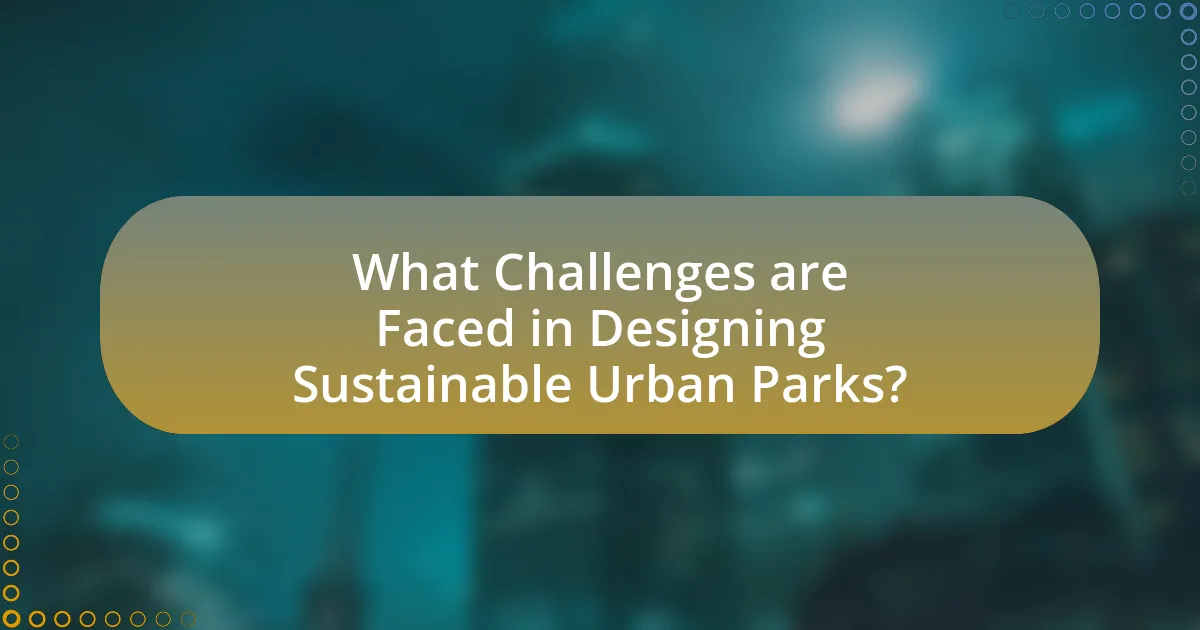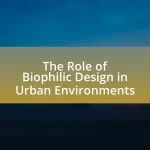Sustainable urban parks are essential green spaces that enhance environmental health, social equity, and economic viability in urban areas. This article outlines the importance of these parks, highlighting their role in improving air quality, managing stormwater, and promoting biodiversity. It discusses the principles guiding their design, such as ecological integrity and community engagement, and identifies best practices for creating these parks, including the use of native vegetation and effective water management systems. Additionally, the article addresses the challenges faced in designing sustainable urban parks and offers strategies for overcoming these obstacles, emphasizing the significance of community involvement and innovative funding solutions.

What are Sustainable Urban Parks?
Sustainable urban parks are green spaces designed to promote environmental health, social equity, and economic viability within urban areas. These parks incorporate native vegetation, sustainable landscaping practices, and features that enhance biodiversity while providing recreational opportunities for communities. For instance, a study by the American Society of Landscape Architects highlights that sustainable urban parks can reduce urban heat islands, improve air quality, and manage stormwater effectively, thereby contributing to the overall resilience of cities.
Why are Sustainable Urban Parks important for cities?
Sustainable urban parks are important for cities because they enhance environmental quality, promote public health, and foster community engagement. These parks contribute to biodiversity by providing habitats for various species, which is crucial in urban areas where natural spaces are limited. Additionally, they improve air quality and reduce urban heat through vegetation, which can lower energy costs for cooling buildings. Studies show that access to green spaces is linked to improved mental health and physical well-being, as people are more likely to engage in outdoor activities in these environments. Furthermore, sustainable urban parks serve as community hubs, encouraging social interaction and cultural activities, which strengthens community ties.
How do Sustainable Urban Parks contribute to environmental health?
Sustainable urban parks contribute to environmental health by enhancing biodiversity, improving air quality, and managing stormwater effectively. These parks provide habitats for various species, which supports ecological balance and promotes biodiversity. For instance, a study published in the journal “Urban Forestry & Urban Greening” found that urban green spaces can increase species richness by up to 30%. Additionally, sustainable parks improve air quality by absorbing pollutants and producing oxygen, with trees capable of removing significant amounts of particulate matter from the air. Furthermore, they play a crucial role in stormwater management by utilizing permeable surfaces and vegetation to reduce runoff, thereby mitigating flooding and water pollution. This multifaceted approach demonstrates how sustainable urban parks are integral to fostering a healthier urban environment.
What social benefits do Sustainable Urban Parks provide to communities?
Sustainable Urban Parks provide numerous social benefits to communities, including enhanced social cohesion, improved mental health, and increased opportunities for physical activity. These parks serve as communal spaces where individuals from diverse backgrounds can gather, fostering interactions that strengthen community ties. Research indicates that access to green spaces is linked to lower levels of stress and anxiety, contributing to better mental well-being. Additionally, parks encourage physical activity by offering safe environments for exercise, which can lead to healthier lifestyles and reduced healthcare costs. Studies show that neighborhoods with accessible parks report higher levels of physical activity among residents, further validating the positive impact of these spaces on community health and social dynamics.
What principles guide the design of Sustainable Urban Parks?
The principles that guide the design of Sustainable Urban Parks include ecological integrity, community engagement, and multifunctionality. Ecological integrity ensures that parks support biodiversity and ecosystem services, such as water filtration and air quality improvement. Community engagement involves involving local residents in the planning process to reflect their needs and preferences, fostering a sense of ownership and stewardship. Multifunctionality emphasizes the design of parks to serve multiple purposes, such as recreation, education, and habitat, maximizing their utility and benefits for urban populations. These principles are supported by studies indicating that parks designed with these considerations lead to enhanced environmental health and improved quality of life for urban residents.
How does ecological design influence park sustainability?
Ecological design significantly enhances park sustainability by integrating natural systems into the planning and management of green spaces. This approach promotes biodiversity, reduces resource consumption, and improves ecosystem services. For instance, parks designed with native plant species can support local wildlife and require less water and maintenance compared to traditional landscaping. Research indicates that parks incorporating ecological design principles can reduce stormwater runoff by up to 65%, thereby mitigating flooding and improving water quality. Additionally, these parks often utilize renewable materials and energy-efficient practices, further contributing to their sustainability.
What role does community engagement play in park design?
Community engagement plays a crucial role in park design by ensuring that the needs and preferences of local residents are incorporated into the planning process. Engaging the community allows designers to gather valuable insights about how the park will be used, what amenities are desired, and how the space can best serve the population. Research indicates that parks designed with community input are more likely to be utilized and maintained, as they reflect the interests and cultural values of the users. For example, a study by the National Recreation and Park Association found that parks that involve community feedback in their design process see a 30% increase in usage compared to those that do not. This demonstrates that community engagement not only enhances user satisfaction but also promotes a sense of ownership and stewardship among residents.

What are the Best Practices for Designing Sustainable Urban Parks?
The best practices for designing sustainable urban parks include incorporating native vegetation, ensuring biodiversity, utilizing sustainable materials, and implementing effective water management systems. Native vegetation supports local wildlife and requires less maintenance, while biodiversity enhances ecosystem resilience. Sustainable materials reduce environmental impact during construction and maintenance. Effective water management, such as rain gardens and permeable surfaces, minimizes runoff and promotes groundwater recharge. These practices are supported by studies indicating that urban parks designed with sustainability in mind can improve air quality, reduce urban heat, and enhance community well-being.
How can natural elements be integrated into park design?
Natural elements can be integrated into park design by incorporating native vegetation, water features, and natural materials. Utilizing native plants enhances biodiversity and reduces maintenance costs, as these species are adapted to local climates and soil conditions. For example, a study by the U.S. Forest Service found that parks with native landscaping can support 50% more wildlife than those with non-native species. Additionally, integrating water features like ponds or streams can improve aesthetics and provide habitats for aquatic life, while also aiding in stormwater management. Using natural materials such as wood and stone in pathways and structures promotes a harmonious connection with the environment, as evidenced by the success of parks like Central Park in New York City, which blends natural landscapes with urban settings.
What types of native plants are best for urban parks?
Native plants that are best for urban parks include species such as coneflowers, black-eyed Susans, and native grasses like little bluestem. These plants are well-suited for urban environments due to their adaptability to local soil and climate conditions, which reduces the need for irrigation and maintenance. Additionally, native plants support local wildlife, including pollinators, by providing essential habitats and food sources. Research indicates that using native plants can enhance biodiversity and improve ecosystem services in urban settings, making them a sustainable choice for park design.
How can water management systems enhance sustainability?
Water management systems enhance sustainability by optimizing the use and conservation of water resources in urban parks. These systems implement techniques such as rainwater harvesting, efficient irrigation, and wastewater recycling, which reduce reliance on potable water and minimize environmental impact. For instance, a study by the American Society of Civil Engineers found that rainwater harvesting can reduce water consumption by up to 50% in urban landscapes. Additionally, smart irrigation systems can adjust watering schedules based on weather conditions, further conserving water. By integrating these practices, water management systems contribute to the overall sustainability of urban parks, promoting ecological balance and resource efficiency.
What design strategies promote biodiversity in urban parks?
Design strategies that promote biodiversity in urban parks include the incorporation of native plant species, the creation of varied habitats, and the implementation of sustainable water management practices. Native plants support local wildlife by providing food and shelter, which enhances ecosystem resilience. For instance, a study by the University of Florida found that parks with native vegetation can support up to 50% more bird species compared to those with non-native plants. Additionally, creating diverse habitats such as meadows, wetlands, and woodlands allows for a wider range of species to thrive. Sustainable water management, including rain gardens and permeable surfaces, helps maintain healthy ecosystems by managing stormwater and reducing pollution. These strategies collectively contribute to a more biodiverse urban environment.
How can habitat creation be incorporated into park layouts?
Habitat creation can be incorporated into park layouts by integrating native plant species, creating diverse ecosystems, and designing specific areas for wildlife. Native plants support local fauna, providing food and shelter, which enhances biodiversity. For instance, parks can include wildflower meadows, wetlands, and native tree groves, which attract pollinators and other wildlife. Research shows that parks with diverse habitats can increase species richness by up to 50%, demonstrating the effectiveness of these strategies in promoting ecological health. Additionally, incorporating features like birdhouses, bat boxes, and insect hotels can further support wildlife, making parks not only recreational spaces but also vital habitats.
What are the benefits of creating green corridors in urban areas?
Creating green corridors in urban areas enhances biodiversity, improves air quality, and promotes physical and mental well-being. These corridors serve as vital habitats for various species, facilitating wildlife movement and supporting ecosystem health. Research indicates that urban green spaces can reduce air pollution levels by up to 30%, contributing to cleaner air for residents. Additionally, studies show that access to green spaces can decrease stress and anxiety, leading to improved mental health outcomes. Furthermore, green corridors can mitigate urban heat effects, lowering temperatures in densely populated areas.

What Challenges are Faced in Designing Sustainable Urban Parks?
Designing sustainable urban parks faces several challenges, including limited space, funding constraints, and the need for community engagement. Limited space in urban areas often restricts the size and scope of parks, making it difficult to incorporate diverse ecosystems and recreational facilities. Funding constraints hinder the ability to implement high-quality materials and sustainable practices, as many urban parks rely on public funding, which can be insufficient. Additionally, engaging the community in the design process is essential for ensuring that the park meets local needs, yet achieving meaningful participation can be challenging due to varying interests and demographics within urban populations. These challenges highlight the complexities involved in creating effective and sustainable urban green spaces.
What are common obstacles to implementing sustainable practices?
Common obstacles to implementing sustainable practices include financial constraints, lack of stakeholder engagement, and insufficient knowledge or expertise. Financial constraints often hinder the allocation of necessary resources for sustainable initiatives, as many organizations prioritize short-term gains over long-term sustainability. Lack of stakeholder engagement can lead to resistance from community members or decision-makers, making it difficult to gain support for sustainable projects. Additionally, insufficient knowledge or expertise among planners and designers can result in ineffective or poorly executed sustainable practices, limiting their potential benefits. These challenges are frequently cited in studies on urban sustainability, such as the “Barriers to Sustainable Urban Development” report by the United Nations, which highlights the importance of addressing these issues to achieve successful implementation.
How can funding limitations impact park design?
Funding limitations can significantly restrict park design by reducing the scope and quality of features that can be included. When budgets are tight, planners may prioritize basic amenities over advanced ecological or recreational elements, leading to simpler designs that lack diversity and functionality. For instance, a study by the National Recreation and Park Association indicates that parks with limited funding often have fewer green spaces, less landscaping, and minimal facilities, which can diminish user experience and community engagement. Consequently, inadequate funding can result in parks that fail to meet the needs of the community, ultimately impacting public health and social interaction.
What regulatory challenges must be navigated in urban planning?
Regulatory challenges in urban planning include zoning laws, environmental regulations, and land use policies. Zoning laws dictate how land can be used, which can restrict the development of sustainable urban parks. Environmental regulations, such as those related to water quality and habitat protection, impose additional requirements that must be met during the planning process. Land use policies can also create conflicts between different stakeholders, such as developers and community members, complicating the approval process for urban park projects. These challenges require careful navigation to ensure compliance while promoting sustainable development.
How can these challenges be overcome?
To overcome challenges in designing sustainable urban parks, stakeholders must engage in collaborative planning that incorporates community input and ecological considerations. This approach ensures that the needs of local residents are met while promoting biodiversity and environmental health. For instance, the use of native plant species can enhance local ecosystems and reduce maintenance costs, as evidenced by studies showing that native plants require less water and are more resilient to local pests. Additionally, implementing green infrastructure, such as rain gardens and permeable pavements, can effectively manage stormwater runoff, thereby mitigating flooding and improving water quality. These strategies demonstrate that a combination of community involvement and ecological practices can successfully address the challenges faced in sustainable urban park design.
What innovative funding strategies can support sustainable parks?
Innovative funding strategies that can support sustainable parks include public-private partnerships, crowdfunding initiatives, and green bonds. Public-private partnerships leverage resources and expertise from both sectors, enabling the development and maintenance of parks while sharing financial risks. For instance, cities like New York have successfully utilized these partnerships to enhance park facilities and services. Crowdfunding initiatives allow community members to contribute directly to park projects, fostering local engagement and ownership; platforms like GoFundMe have been used for specific park improvements. Green bonds, which are debt instruments specifically for financing environmentally sustainable projects, have been adopted by municipalities to fund park development, as seen in cities like San Francisco, where green bonds have financed urban greening efforts. These strategies not only provide financial resources but also promote community involvement and environmental stewardship.
How can collaboration with local organizations enhance park projects?
Collaboration with local organizations can enhance park projects by leveraging community knowledge, resources, and volunteer support. Local organizations often possess valuable insights into the specific needs and preferences of the community, which can inform the design and functionality of park spaces. For instance, partnerships with environmental groups can lead to the incorporation of native plant species, promoting biodiversity and sustainability. Additionally, local organizations can mobilize volunteers for maintenance and programming, reducing costs and fostering a sense of ownership among residents. Research indicates that parks developed with community input are more likely to meet user needs and achieve higher usage rates, as evidenced by studies showing increased park visitation in areas where local stakeholders were actively involved in the planning process.
What are practical tips for creating successful Sustainable Urban Parks?
To create successful Sustainable Urban Parks, prioritize native plant selection to enhance biodiversity and reduce maintenance costs. Native plants are adapted to local climates and soil conditions, requiring less water and fertilizer, which supports local wildlife and ecosystems. Incorporate green infrastructure, such as rain gardens and permeable pavements, to manage stormwater effectively and reduce urban heat. Research indicates that parks with diverse ecosystems can improve air quality and provide recreational opportunities, contributing to community well-being. Engage the community in the design process to ensure the park meets local needs and fosters a sense of ownership, which is crucial for long-term sustainability. Studies show that community involvement leads to higher usage rates and better maintenance outcomes.
How can ongoing maintenance be planned for sustainability?
Ongoing maintenance can be planned for sustainability by implementing a proactive maintenance schedule that prioritizes ecological health and resource efficiency. This involves regularly assessing the park’s natural systems, such as soil health, plant diversity, and water management, to ensure they remain resilient and functional. For instance, using native plant species reduces the need for irrigation and chemical fertilizers, promoting biodiversity and lowering maintenance costs. Additionally, integrating sustainable practices like composting organic waste and utilizing rainwater harvesting systems can enhance resource conservation. Research indicates that parks designed with sustainability in mind, such as those incorporating green infrastructure, can reduce long-term maintenance costs by up to 30% while improving environmental outcomes.
What role does community feedback play in park success?
Community feedback is crucial for park success as it directly influences design, functionality, and user satisfaction. Engaging local residents in the planning process ensures that parks meet the specific needs and preferences of the community, leading to higher usage rates and better maintenance. Research indicates that parks designed with community input are more likely to foster social interaction and promote physical activity, which are essential for community health and well-being. For instance, a study by the National Recreation and Park Association found that parks that incorporate user feedback see a 30% increase in visitor satisfaction and a 25% increase in community engagement. This evidence underscores the importance of community feedback in creating parks that are not only functional but also cherished by the community.


